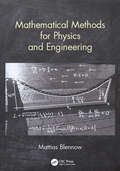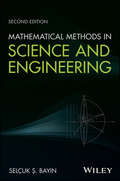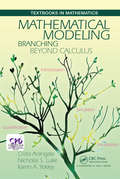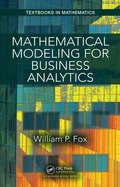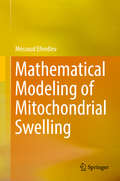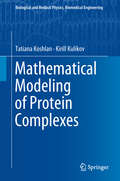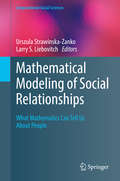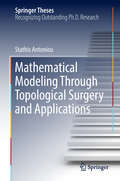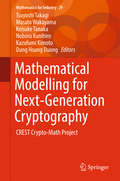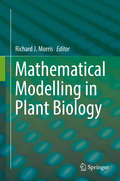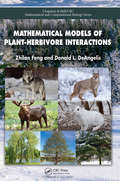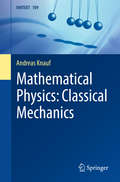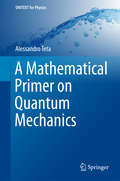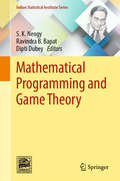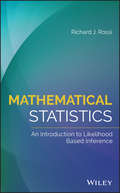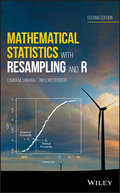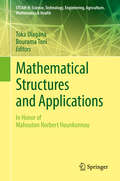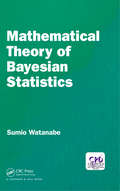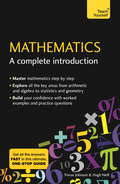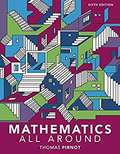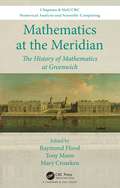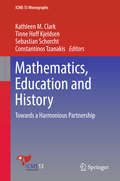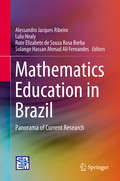- Table View
- List View
Mathematical Methods for Physics and Engineering
by Mattias BlennowSuitable for advanced undergraduate and graduate students, this new textbook contains an introduction to the mathematical concepts used in physics and engineering. <p><p>The entire book is unique in that it draws upon applications from physics, rather than mathematical examples, to ensure students are fully equipped with the tools they need. This approach prepares the reader for advanced topics, such as quantum mechanics and general relativity, while offering examples, problems, and insights into classical physics. <p><p>The book is also distinctive in the coverage it devotes to modelling, and to oft-neglected topics such as Green's functions.
Mathematical Methods in Science and Engineering
by Selçuk S. BayinA Practical, Interdisciplinary Guide to Advanced Mathematical Methods for Scientists and Engineers Mathematical Methods in Science and Engineering, Second Edition, provides students and scientists with a detailed mathematical reference for advanced analysis and computational methodologies. Making complex tools accessible, this invaluable resource is designed for both the classroom and the practitioners; the modular format allows flexibility of coverage, while the text itself is formatted to provide essential information without detailed study. Highly practical discussion focuses on the “how-to” aspect of each topic presented, yet provides enough theory to reinforce central processes and mechanisms. Recent growing interest in interdisciplinary studies has brought scientists together from physics, chemistry, biology, economy, and finance to expand advanced mathematical methods beyond theoretical physics. This book is written with this multi-disciplinary group in mind, emphasizing practical solutions for diverse applications and the development of a new interdisciplinary science. Revised and expanded for increased utility, this new Second Edition: Includes over 60 new sections and subsections more useful to a multidisciplinary audience Contains new examples, new figures, new problems, and more fluid arguments Presents a detailed discussion on the most frequently encountered special functions in science and engineering Provides a systematic treatment of special functions in terms of the Sturm-Liouville theory Approaches second-order differential equations of physics and engineering from the factorization perspective Includes extensive discussion of coordinate transformations and tensors, complex analysis, fractional calculus, integral transforms, Green's functions, path integrals, and more Extensively reworked to provide increased utility to a broader audience, this book provides a self-contained three-semester course for curriculum, self-study, or reference. As more scientific disciplines begin to lean more heavily on advanced mathematical analysis, this resource will prove to be an invaluable addition to any bookshelf.
Mathematical Modeling: Branching Beyond Calculus (Textbooks in Mathematics)
by Crista Arangala Nicolas S. Luke Karen A. Yokley<p>Mathematical Modeling: Branching Beyond Calculus reveals the versatility of mathematical modeling. The authors present the subject in an attractive manner and flexibley manner. Students will discover that the topic not only focuses on math, but biology, engineering, and both social and physical sciences. <p>The book is written in a way to meet the needs of any modeling course. Each chapter includes examples, exercises, and projects offering opportunities for more in-depth investigations into the world of mathematical models. The authors encourage students to approach the models from various angles while creating a more complete understanding. The assortment of disciplines covered within the book and its flexible structure produce an intriguing and promising foundation for any mathematical modeling course or for self-study.</p>
Mathematical Modeling for Business Analytics (Textbooks in Mathematics)
by William P. FoxMathematical Modeling for Business Analytics is written for decision makers at all levels. This book presents the latest tools and techniques available to help in the decision process. The interpretation and explanation of the results are crucial to understanding the strengths and limitations of modeling. This book emphasizes and focuses on the aspects of constructing a useful model formulation, as well as building the skills required for decision analysis. The book also focuses on sensitivity analysis. The author encourages readers to formally think about solving problems by using a thorough process. Many scenarios and illustrative examples are provided to help solve problems. Each chapter is also comprehensively arranged so that readers gain an in-depth understanding of the subject which includes introductions, background information and analysis. Both undergraduate and graduate students taking methods courses in methods and discrete mathematical modeling courses will greatly benefit from using this book. Boasts many illustrative examples to help solve problems Provides many solutions for each chapter Emphasizes model formulation and helps create model building skills for decision analysis Provides the tools to support analysis and interpretation
Mathematical Modeling of Mitochondrial Swelling
by Messoud EfendievThe mathematical models considered in this book can help to understand the swelling of mitochondria. For the first time, it presents new mathematical models of mitochondrial swelling that take into account, in particular, spatial effects. The results presented here could make it possible to predict properties of the underlying biological mechanisms. Taking into account that mitochondria could move within a cell, lead to a PDE-PDE model. The book discusses the well-posedness and long-term dynamics of solutions, depending on boundary conditions reflecting the in vitro and in vivo cases. These analytical and numerical results have inspired colleagues from the Institute of Pharmacology and Toxicology of the Helmholtz Center Munich to design new experiments justifying the theoretical and numerical results that are obtained. The book is intended for graduates students and researchers with a solid mathematical background and an interest in cell biology.
Mathematical Modeling of Protein Complexes (Biological and Medical Physics, Biomedical Engineering)
by Tatiana Koshlan Kirill KulikovThis book is devoted to the physical and mathematical modeling of the formation of complexes of protein molecules. The models developed show remarkable sensitivity to the amino acid sequences of proteins, which facilitates experimental studies and allows one to reduce the associated costs by reducing the number of measurements required according to the developed criteria. These models make it possible to reach a conclusion about the interactions between different amino acid chains and to identify more stable sites on proteins. The models also take the phosphorylation of amino acid residues into account. At the end of the book, the authors present possible directions of application of their physical and mathematical models in clinical medicine.
Mathematical Modeling of Social Relationships: What Mathematics Can Tell Us About People (Computational Social Sciences)
by Urszula Strawinska-Zanko Larry S. LiebovitchThis edited volume presents examples of social science research projects that employ new methods of quantitative analysis and mathematical modeling of social processes. This book presents the fascinating areas of empirical and theoretical investigations that use formal mathematics in a way that is accessible for individuals lacking extensive expertise but still desiring to expand their scope of research methodology and add to their data analysis toolbox. Mathematical Modeling of Social Relationships professes how mathematical modeling can help us understand the fundamental, compelling, and yet sometimes complicated concepts that arise in the social sciences. This volume will appeal to upper-level students and researchers in a broad area of fields within the social sciences, as well as the disciplines of social psychology, complex systems, and applied mathematics.
Mathematical Modeling Through Topological Surgery and Applications (Springer Theses)
by Stathis AntoniouTopological surgery is a mathematical technique used for creating new manifolds out of known ones. In this book the authors observe that it also occurs in natural phenomena of all scales: 1-dimensional surgery happens during DNA recombination and when cosmic magnetic lines reconnect; 2-dimensional surgery happens during tornado formation and cell mitosis; and they conjecture that 3-dimensional surgery happens during the formation of black holes from cosmic strings, offering an explanation for the existence of a black hole’s singularity. Inspired by such phenomena, the authors present a new topological model that extends the formal definition to a continuous process caused by local forces. Lastly, they describe an intrinsic connection between topological surgery and a chaotic dynamical system exhibiting a “hole drilling” behavior. The authors’ model indicates where to look for the forces causing surgery and what deformations should be observed in the local submanifolds involved. These predictions are significant for the study of phenomena exhibiting surgery and they also open new research directions. This novel study enables readers to gain a better understanding of the topology and dynamics of various natural phenomena, as well as topological surgery itself and serves as a basis for many more insightful observations and new physical implications.
Mathematical Modelling for Next-Generation Cryptography
by Tsuyoshi Takagi Masato Wakayama Keisuke Tanaka Noboru Kunihiro Kazufumi Kimoto Dung Hoang DuongThis book presents the mathematical background underlying security modeling in the context of next-generation cryptography. By introducing new mathematical results in order to strengthen information security, while simultaneously presenting fresh insights and developing the respective areas of mathematics, it is the first-ever book to focus on areas that have not yet been fully exploited for cryptographic applications such as representation theory and mathematical physics, among others. Recent advances in cryptanalysis, brought about in particular by quantum computation and physical attacks on cryptographic devices, such as side-channel analysis or power analysis, have revealed the growing security risks for state-of-the-art cryptographic schemes. To address these risks, high-performance, next-generation cryptosystems must be studied, which requires the further development of the mathematical background of modern cryptography. More specifically, in order to avoid the security risks posed by adversaries with advanced attack capabilities, cryptosystems must be upgraded, which in turn relies on a wide range of mathematical theories. This book is suitable for use in an advanced graduate course in mathematical cryptography, while also offering a valuable reference guide for experts.
Mathematical Modelling in Plant Biology
by Richard J. MorrisProgress in plant biology relies on the quantification, analysis and mathematical modeling of data over different time and length scales. This book describes common mathematical and computational approaches as well as some carefully chosen case studies that demonstrate the use of these techniques to solve problems at the forefront of plant biology. Each chapter is written by an expert in field with the goal of conveying concepts whilst at the same time providing sufficient background and links to available software for readers to rapidly build their own models and run their own simulations. This book is aimed at postgraduate students and researchers working the field of plant systems biology and synthetic biology, but will also be a useful reference for anyone wanting to get into quantitative plant biology.
Mathematical Models of Plant-Herbivore Interactions (Chapman & Hall/CRC Mathematical Biology Series)
by Zhilan Feng Donald DeAngelisMathematical Models of Plant-Herbivore Interactions addresses mathematical models in the study of practical questions in ecology, particularly factors that affect herbivory, including plant defense, herbivore natural enemies, and adaptive herbivory, as well as the effects of these on plant community dynamics. <P><P> The result of extensive research on the use of mathematical modeling to investigate the effects of plant defenses on plant-herbivore dynamics, this book describes a toxin-determined functional response model (TDFRM) that helps explains field observations of these interactions. <P><P> This book is intended for graduate students and researchers interested in mathematical biology and ecology.
Mathematical Physics: Classical Mechanics (UNITEXT #109)
by Andreas Knauf Jochen DenzlerAs a limit theory of quantum mechanics, classical dynamics comprises a large variety of phenomena, from computable (integrable) to chaotic (mixing) behavior. This book presents the KAM (Kolmogorov-Arnold-Moser) theory and asymptotic completeness in classical scattering. Including a wealth of fascinating examples in physics, it offers not only an excellent selection of basic topics, but also an introduction to a number of current areas of research in the field of classical mechanics. Thanks to the didactic structure and concise appendices, the presentation is self-contained and requires only knowledge of the basic courses in mathematics.The book addresses the needs of graduate and senior undergraduate students in mathematics and physics, and of researchers interested in approaching classical mechanics from a modern point of view.
A Mathematical Primer on Quantum Mechanics (UNITEXT for Physics)
by Alessandro TetaThis book offers a rigorous yet elementary approach to quantum mechanics that will meet the needs of Master’s-level Mathematics students and is equally suitable for Physics students who are interested in gaining a deeper understanding of the mathematical structure of the theory. Throughout the coverage, which is limited to single-particle quantum mechanics, the focus is on formulating theory and developing applications in a mathematically precise manner. Following a review of selected key concepts in classical physics and the historical background, the basic elements of the theory of operators in Hilbert spaces are presented and used to formulate the rules of quantum mechanics. The discussion then turns to free particles, harmonic oscillators, delta potential, and hydrogen atoms, providing rigorous proofs of the corresponding dynamical properties. Starting from an analysis of these applications, readers are subsequently introduced to more advanced topics such as the classical limit, scattering theory, and spectral analysis of Schrödinger operators. The main content is complemented by numerous exercises that stimulate interactive learning and help readers check their progress.
Mathematical Programming and Game Theory (Indian Statistical Institute Series)
by S. K. Neogy Ravindra B. Bapat Dipti DubeyThis book discusses recent developments in mathematical programming and game theory, and the application of several mathematical models to problems in finance, games, economics and graph theory. All contributing authors are eminent researchers in their respective fields, from across the world. This book contains a collection of selected papers presented at the 2017 Symposium on Mathematical Programming and Game Theory at New Delhi during 9–11 January 2017. Researchers, professionals and graduate students will find the book an essential resource for current work in mathematical programming, game theory and their applications in finance, economics and graph theory. The symposium provides a forum for new developments and applications of mathematical programming and game theory as well as an excellent opportunity to disseminate the latest major achievements and to explore new directions and perspectives.
Mathematical Statistics: An Introduction to Likelihood Based Inference
by Richard J. RossiPresents a unified approach to parametric estimation, confidence intervals, hypothesis testing, and statistical modeling, which are uniquely based on the likelihood function This book addresses mathematical statistics for upper-undergraduates and first year graduate students, tying chapters on estimation, confidence intervals, hypothesis testing, and statistical models together to present a unifying focus on the likelihood function. It also emphasizes the important ideas in statistical modeling, such as sufficiency, exponential family distributions, and large sample properties. Mathematical Statistics: An Introduction to Likelihood Based Inference makes advanced topics accessible and understandable and covers many topics in more depth than typical mathematical statistics textbooks. It includes numerous examples, case studies, a large number of exercises ranging from drill and skill to extremely difficult problems, and many of the important theorems of mathematical statistics along with their proofs. In addition to the connected chapters mentioned above, Mathematical Statistics covers likelihood-based estimation, with emphasis on multidimensional parameter spaces and range dependent support. It also includes a chapter on confidence intervals, which contains examples of exact confidence intervals along with the standard large sample confidence intervals based on the MLE's and bootstrap confidence intervals. There’s also a chapter on parametric statistical models featuring sections on non-iid observations, linear regression, logistic regression, Poisson regression, and linear models. Prepares students with the tools needed to be successful in their future work in statistics data science Includes practical case studies including real-life data collected from Yellowstone National Park, the Donner party, and the Titanic voyage Emphasizes the important ideas to statistical modeling, such as sufficiency, exponential family distributions, and large sample properties Includes sections on Bayesian estimation and credible intervals Features examples, problems, and solutions Mathematical Statistics: An Introduction to Likelihood Based Inference is an ideal textbook for upper-undergraduate and graduate courses in probability, mathematical statistics, and/or statistical inference.
Mathematical Statistics with Resampling and R: With Applications And R Set
by Laura M. Chihara Tim C. HesterbergThis thoroughly updated second edition combines the latest software applications with the benefits of modern resampling techniques Resampling helps students understand the meaning of sampling distributions, sampling variability, P-values, hypothesis tests, and confidence intervals. The second edition of Mathematical Statistics with Resampling and R combines modern resampling techniques and mathematical statistics. This book has been classroom-tested to ensure an accessible presentation, uses the powerful and flexible computer language R for data analysis and explores the benefits of modern resampling techniques. This book offers an introduction to permutation tests and bootstrap methods that can serve to motivate classical inference methods. The book strikes a balance between theory, computing, and applications, and the new edition explores additional topics including consulting, paired t test, ANOVA and Google Interview Questions. Throughout the book, new and updated case studies are included representing a diverse range of subjects such as flight delays, birth weights of babies, and telephone company repair times. These illustrate the relevance of the real-world applications of the material. This new edition: • Puts the focus on statistical consulting that emphasizes giving a client an understanding of data and goes beyond typical expectations • Presents new material on topics such as the paired t test, Fisher's Exact Test and the EM algorithm • Offers a new section on "Google Interview Questions" that illustrates statistical thinking • Provides a new chapter on ANOVA • Contains more exercises and updated case studies, data sets, and R code Written for undergraduate students in a mathematical statistics course as well as practitioners and researchers, the second edition of Mathematical Statistics with Resampling and R presents a revised and updated guide for applying the most current resampling techniques to mathematical statistics.
Mathematical Structures and Applications: In Honor Of Mahouton Norbert Hounkonnou (STEAM-H: Science, Technology, Engineering, Agriculture, Mathematics & Health)
by Toka Diagana Bourama ToniThis contributed volume features invited papers on current research and applications in mathematical structures. Featuring various disciplines in the mathematical sciences and physics, articles in this volume discuss fundamental scientific and mathematical concepts as well as their applications to topical problems. Special emphasis is placed on important methods, research directions and applications of analysis within and beyond each field. Covered topics include Metric operators and generalized hermiticity, Semi-frames, Hilbert-Schmidt operator, Symplectic affine action, Fractional Brownian motion, Walker Osserman metric, Nonlinear Maxwell equations, The Yukawa model, Heisenberg observables, Nonholonomic systems, neural networks, Seiberg-Witten invariants, photon-added coherent state, electrostatic double layers, and star products and functions. All contributions are from the participants of the conference held October 2016 in Cotonou, Benin in honor of Professor Mahouton Norbert Hounkonnou for his outstanding contributions to the mathematical and physical sciences and education. Accessible to graduate students and postdoctoral researchers, this volume is a useful resource to applied scientists, applied and pure mathematicians, and mathematical and theoretical physicists.
Mathematical Theory of Bayesian Statistics
by Sumio WatanabeMathematical Theory of Bayesian Statistics introduces the mathematical foundation of Bayesian inference which is well-known to be more accurate in many real-world problems than the maximum likelihood method. Recent research has uncovered several mathematical laws in Bayesian statistics, by which both the generalization loss and the marginal likelihood are estimated even if the posterior distribution cannot be approximated by any normal distribution. <P><P> Features <li>Explains Bayesian inference not subjectively but objectively. <li>Provides a mathematical framework for conventional Bayesian theorems. <li>Introduces and proves new theorems. <li>Cross validation and information criteria of Bayesian statistics are studied from the mathematical point of view. <li>Illustrates applications to several statistical problems, for example, model selection, hyperparameter optimization, and hypothesis tests. <li>This book provides basic introductions for students, researchers, and users of Bayesian statistics, as well as applied mathematicians. <P><P>Author <P><P>Sumio Watanabe is a professor of Department of Mathematical and Computing Science at Tokyo Institute of Technology. He studies the relationship between algebraic geometry and mathematical statistics.
Mathematics: Bullet Guides
by Sophie GoldieOpen this book and you will Be numerate Understand key principles Conquer difficult problems Handle data confidently
Mathematics: The Easy Way to Learn Maths
by Hugh Neill Trevor JohnsonMaths does not have to be difficult. This book, complete with exercises and answers, forms a course which will take you from beginner or intermediate level to being a confident mathematician. This book includes: simple step-by-step explanations, to help you grasp new topics or those that have previously confused you; practice questions throughout, to help you embed your learning and improve your confidence; and end of chapter summaries, to help you remember the key points you've learned - all in one great-value book, so you don't need any separate workbooks or coursebooks.Chapters include: number; angles; fractions; two-dimensional shapes; decimals; statisticsl directed numbers; graphs; measurement; perimeter and area; algebraic expressions; approximations; equations; percentages; formulae; circles; probability; three-dimensional shapes; ratio and proportion; pythagoras' theorem and trigonometry; indices and standard form.ABOUT THE SERIESThe Complete Introduction series from Teach Yourself is the ultimate one-stop guide for anyone wanting a comprehensive and accessible entry point into subjects as diverse as philosophy, mathematics, psychology, Shakespeare and practical electronics. Loved by students and perfect for general readers who simply want to learn more about the world around them, these books are your first choice for discovering something new.
Mathematics All Around
by Tom PirnotGiven their widely varying backgrounds, students in Liberal Arts Math often enter the course with math anxiety. Pirnot’s Mathematics All Around, 6th Edition offers the supportive and patient writing style that students need to overcome that apprehension, developing useful skills through realistic applications that can be seen in the world around them. Relevant and approachable, the author’s tone resembles the support students would receive during an instructor’s office hours. The author emphasizes a problem-solving approach, reinforcing problem-solving methods and how to apply them throughout the text. The 6th Edition keeps students engaged with updated real-world applications, while also providing more support as they learn with new measurable objectives, revised exercise sets, significant enhancements to each chapter, as well as a new student Workbook.
Mathematics at the Meridian: The History of Mathematics at Greenwich (Chapman & Hall/CRC Numerical Analysis and Scientific Computing Series)
by Raymond Flood Tony Mann Mary CroarkenGreenwich has been a centre for scientific computing since the foundation of the Royal Observatory in 1675. Early Astronomers Royal gathered astronomical data with the purpose of enabling navigators to compute their longitude at sea. Nevil Maskelyne in the 18th century organised the work of computing tables for the Nautical Almanac, anticipating later methods used in safety-critical computing systems. The 19th century saw influential critiques of Charles Babbage’s mechanical calculating engines, and in the 20th century Leslie Comrie and others pioneered the automation of computation. The arrival of the Royal Naval College in 1873 and the University of Greenwich in 1999 has brought more mathematicians and different kinds of mathematics to Greenwich. In the 21st century computational mathematics has found many new applications. This book presents an account of the mathematicians who worked at Greenwich and their achievements. Features A scholarly but accessible history of mathematics at Greenwich, from the seventeenth century to the present day, with each chapter written by an expert in the field The book will appeal to astronomical and naval historians as well as historians of mathematics and scientific computing.
Mathematics: Bullet Guides
by Sophie GoldieOpen this book and you will Be numerate Understand key principles Conquer difficult problems Handle data confidently
Mathematics, Education and History: Towards A Harmonious Partnership (ICME-13 Monographs)
by Constantinos Tzanakis Sebastian Schorcht Tinne Hoff Kjeldsen Kathleen M. ClarkThis book includes 18 peer-reviewed papers from nine countries, originally presented in a shorter form at TSG 25 The Role of History of Mathematics in Mathematics Education, as part of ICME-13 during. It also features an introductory chapter, by its co-editors, on the structure and main points of the book with an outline of recent developments in exploring the role of history and epistemology in mathematics education. It serves as a valuable contribution in this domain, by making reports on recent developments in this field available to the international educational community, with a special focus on relevant research results since 2000. The 18 chapters of the book are divided into five interrelated parts that underlie the central issues of research in this domain: 1. Theoretical and conceptual frameworks for integrating history and epistemology in mathematics in mathematics education; 2. Courses and didactical material: Design, implementation and evaluation; 3. Empirical investigations on implementing history and epistemology in mathematics education; 4. Original historical sources in teaching and learning of and about mathematics; 5. History and epistemology of mathematics: Interdisciplinary teaching and sociocultural aspects. This book covers all levels of education, from primary school to tertiary education, with a particular focus on teacher education. Additionally, each chapter refers to and/or is based on empirical research, in order to support, illuminate, clarify and evaluate key issues, main questions, and conjectured theses raised by the authors or in the literature on the basis of historical-epistemological or didactical-cognitive arguments.
Mathematics Education in Brazil: Panorama of Current Research
by Alessandro Jacques Ribeiro Lulu Healy Rute Elizabete Borba Solange Hassan FernandesThis book presents, for the first time in English, the state of the art of Mathematics Education research in Brazil, a country that has the strongest community in this field in Latin America. Edited by leading researchers in the area, the volume provides the international academic community a summary of the scientific production of the thirteen working groups of the Brazilian Society of Mathematics Education (SBEM), the national scientific society that brings together researchers, teachers, students and other professionals of the area. These working groups meet every three years at the International Seminar of Mathematics Education (SIPEM) and cover the following topics: Mathematics Education in the Early Years and Primary Education (Y1-Y5); Mathematics Education in the Middle School (Y6-Y9); Mathematics Education in the High School (Y10-Y12); Mathematics Education at the University level; History of Mathematics, Culture and Mathematics Education; Digital Technologies and Distance Education; Teacher Education; Assessment and Mathematics Education; Cognitive and Linguistic Processes in Mathematics Education; Mathematical Modeling; Philosophy of Mathematics Education, Teaching Probability and Statistics; and Difference, Inclusion and Mathematics Education. Each chapter of the book presents an overview of the production of a working group and they are all preceded by an introduction by professor Ubiratan D’Ambrosio, one of the pioneers of Mathematics Education in Brazil.
